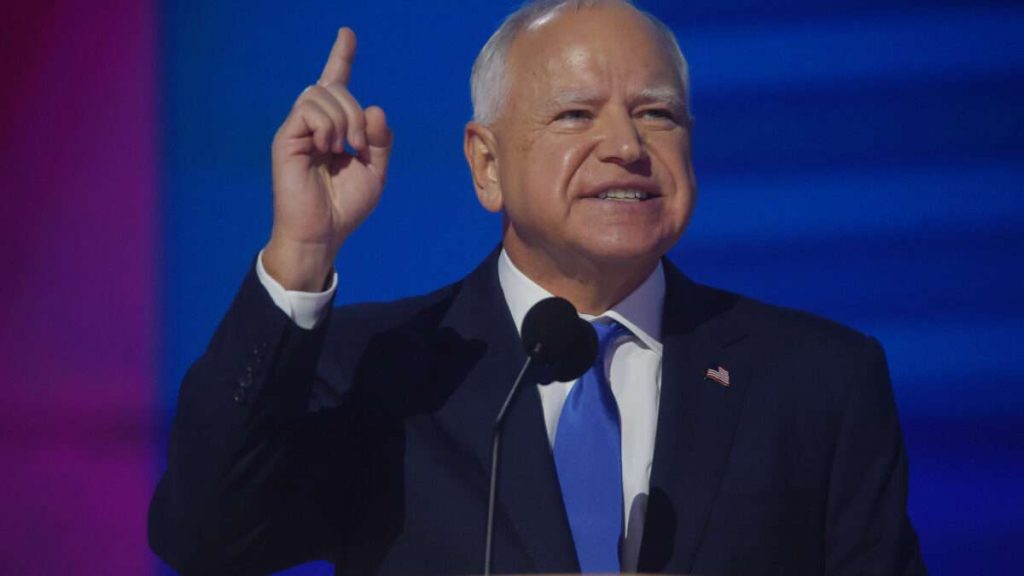Toward the end of Tuesday night’s vice presidential debate, Minnesota Gov. Tim Walz (D) argued with Sen. J.D. Vance (R–Ohio) about former President Donald Trump’s efforts to remain in power following his 2020 election loss. Trump’s conduct was indefensible, and thus Vance did not do a very good job defending it. Rather, he attempted to turn the tables on Walz, accusing the Democratic ticket of disrespecting the most important democratic norm of all: free speech.
“You guys attack us for not believing in democracy,” said Vance. “The most sacred right under United States democracy is the First Amendment.”
Vance went on to accuse Walz of wanting to criminalize misinformation, referencing previous, inaccurate comments the governor made about exceptions to the First Amendment. At that point, Walz actually interrupted Vance, and claimed that the First Amendment does not protect misinformation or “threatening or hate speech.”
Tim Walz doubles down on his claim that “misinformation and hate speech” aren’t protected by the First Amendment. pic.twitter.com/cGeoWEJnF1
— Alpha News (@AlphaNewsMN) October 2, 2024
In other words, misinformation, threats, and hate speech are all unprotected categories of speech, according to Walz.
But the governor is mostly, very wrong. He’s correct to note that true threats of violence lack First Amendment protection if they are specific enough. Misinformation and hate speech are absolutely protected by the First Amendment, however. And while the former is a relatively new category of expression facing explicit calls for censorship, the latter category—hate speech—has been exhaustively litigated before the Supreme Court.
Don’t Hate the Player
Walz defended his position by glibly asserting that it is constitutionally impermissible to yell “fire in a crowded theater.” This is an oft-expressed sentiment—and one that’s completely and utterly false. It comes from the Supreme Court’s odious opinion in the 1919 case Schenk v. United States, in which the majority held that the government could stop people from distributing leaflets opposing World War I. Justice Oliver Wendell Holmes likened such activism as akin to yelling fire in a crowded theater; in other words, he believed that raising doubts about the desirability of the U.S. participating in such a global catastrophe was dangerous, and could be prohibited.
Today we recognize that the right to criticize U.S. military policy and oppose foreign wars is an essential component of the First Amendment. And the Supreme Court agrees: Schenk was gradually overturned by subsequent decisions. The right to engage in speech that the government might deem reckless, dangerous, or hateful was explicitly affirmed in the 2017 case Matal v. Tam, in which Justice Samuel Alito observed “the proudest boast of our free speech jurisprudence is that we protect the freedom to express ‘the thought that we hate.'” It could not be more simple: Hate speech is protected by the First Amendment.
This shouldn’t be surprising; after all, if hate speech constituted unprotected speech, it would create all sorts of problems. What counts as hateful speech is purely subjective. Religious people, for instance, might find blasphemy to be hateful—but it’s sufficiently obvious that the federal government cannot criminalize criticism of religion. Similarly, political figures might determine that their opponents running attack ads against them are examples of hateful messaging. If censorship was allowed on this basis, there would be no end in sight.
It’s incredibly common to hear otherwise informed persons try to draw some distinction between hate speech and free speech, but they are misinformed: From the standpoint of the First Amendment, there is no recognized difference. Hate speech is free speech.
Misinformation is no different. The Supreme Court has not specifically taken up the question, but it should be sufficiently obvious that people can disagree on what is true and what is false. The Enlightenment principle that undergirds the First Amendment and democracy itself is that the best way to counter bad information is to allow everyone to speak. Investing some central government authority with the power to determine what is true can backfire horribly, since the government is frequently wrong. Indeed, the COVID-19 pandemic provides a powerful illustration of why criminalizing misinformation is a fraught project: Time and time again, the expert consensus among government bureaucrats was proven to be flawed, incomplete, or flat-out wrong. People need the right to disagree with one another, and with their government. Thankfully, Americans enjoy that protection under the First Amendment. There is no misinformation exception.
It’s true that many progressive elites wish that they had the power to censor misinformation. Take, for instance, former Secretary of State John Kerry, who recently lamented that the First Amendment was a “major block” to tackling this problem. The tone of Kerry’s remarks suggests that he is not altogether thrilled about this. But as he begrudgingly acknowledges, the U.S. is different from every country on earth, in that its laws significantly constrain the federal government’s speech-related policy making.
Walz, however, doesn’t seem to recognize this fact. That’s very worrying. After all, the Biden administration went to great lengths to test the boundaries of the First Amendment and pressure social media companies to engage in suppression of disfavored speech. That was the thrust of Vance’s criticism: He accused Democrats of counteracting democracy for explicitly supporting censorship on social media.
Walz could have neutralized this line of attack by affirming that the federal government cannot and should not work to forcibly remove misinformation and hate speech from internet platforms. He declined to do so. Worse than that, he clearly considers misinformation to be a form of expression that is beyond the realm of First Amendment protection.
This Week on Free Media
We are taking a two-week hiatus, but Free Media will be back later this month. I’m pleased to announce that we have expansionary ambitions, and will be working with a new producer to deliver even more content.
In the meantime, here was Rising‘s reaction to the veep debate.
Worth Watching
I am now all caught up on The Lord of the Rings: The Rings of Power. I initially gave it a very mixed review, but the second season has grown on me.
This is mostly due to a single performance: Charles Edwards as the elven smith Celebrimbor, who falls under the influence of the dark lord Sauron (Charlie Vickers). In the most recent and penultimate episode of Rings of Power, Sauron traps Celebrimbor in sort of time-displaced prison within his workshop and gaslights him into completing work on the rings while orcs lay siege to the city around them. It’s an inspired plot point.
Too many of the Rings of Power characters are one-dimensional and uninteresting—the dwarf Durin, the elf Arondir, basically everybody in Numenor—or pail imitations of their better-loved selves from the films (Galadriel, Elrond). But Celebrimbor is relatable and tragic: Sauron’s manipulations of him are subtle and believable. I’m reminded of another one of my favorite lesser characters from a popular work of fantasy: Qyburn, the twisted ex-maester in Game of Thrones. Neither Celebrimbor nor Qyburn are evil; they’re just curious, and thus vulnerable to corruption. They can’t help themselves if they see a shiny object and wonder what they can do with it.
The post Tim Walz’s Very Bad Answer on Social Media Censorship appeared first on Reason.com.






